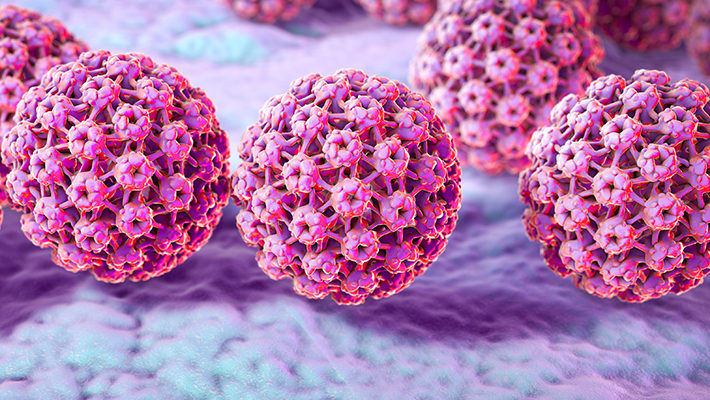Evidence generated by the Daffodil Centre’s Cervical Cancer and HPV Stream continues to make a significant contribution to both national and international policy development for cervical cancer control. The team’s work spans modelling, observational epidemiology, clinical trials, and data analysis to support the elimination of cervical cancer as a public health problem.
This week, the team present their latest research at the International Papillomavirus Conference (IPVC). Below is a summary of the research being presented.
The impact of COVID-19 on HPV-related cancers
Prof Karen Canfell was a keynote speaker at the interdisciplinary workshop, summarising the latest work of the team and collaborators on the impact of the pandemic on HPV-related cancers. She covered the work of three different modelling consortia which she co-leads – NCI’s CISNET consortium in the USA, the COVID and Cancer Global Modelling Consortium (CCGMC), and the WHO Cervical Cancer Elimination Modelling Consortium (CCEMC). Key messages for decision-makers include the increased resilience of HPV screening vs cytology-based programs for high income countries, and the huge cost in lives lost resulting from delays to efforts to elimination of cervical cancer.
Cervical cancer screening and equity in Australia
Underpinned by earlier research by the Cervical Cancer and HPV Stream, Australia’s National Cervical Screening Program transitioned to 5-yearly primary HPV testing in December 2017. Dr Megan Smith presents our new research detailing the performance of the renewed screening program in the first two years. Chloe Jennett presents complementary research documenting the experiences of a range of stakeholders following the transition from cytology to primary HPV testing for cervical screening in Australia. The distilled learnings will support other countries transitioning to primary HPV testing.
Australia is on track to eliminate cervical cancer as a public health problem by 2028, however, the risk of developing cervical cancer and dying from the disease remains substantially higher in Indigenous women. Dr Megan Smith presents on research assessing the potential impact of screening strategies appropriate to Indigenous women.
Informing the World Health Organization’s 2021 cervical screening guidelines
The Cervical Cancer and HPV Stream were the sole modelling team involved in the evaluation of screening algorithms to inform the WHO World Health Organization (WHO) 2021 cervical screening guidelines. Across four IPVC oral presentations Drs Kate Simms, Adam Keane, Michaela Hall and Diep Nguyen share this research, which shows that primary HPV screening is a more effective and cost-effective approach to reducing cervical cancer incidence and mortality compared to other screening approaches. These findings directly informed updated 2021 cervical screening guidelines by the WHO, which recommend using HPV DNA detection in a screen-and-treat approach, or in a screen, triage and treat approach, starting at the age of 30 years with regular screening every 5 or 10 years for women in the general population, or HPV DNA detection in a screen, triage and treat approach starting at the age of 25 years with a regular screening of every 3 or 5 years for women living with HIV.
The impact of COVID-19 pandemic on cervical cancer control
Via the CCGMC, the Cervical Cancer and HPV Stream are investigating the impact of the COVID-19 pandemic on cervical cancer control. Dr Megan Smith presents our CCGMC research looking at the impact of disruptions to cervical screening programs across a range of high-income countries. Dr Kate Simms presents our new research on the impact of the pandemic on 78 low- and middle-income countries reaching targets for HPV vaccination, cervical screening and cervical cancer treatment, including modelled predictions of the additional cases and deaths due to delays in scaling up these interventions.
HPV screening in HPV vaccinated populations
The group present several new clinical trial and modelling results related to cervical screening in HPV-vaccinated populations.
In the conference ‘late-breakers’ session Prof Karen Canfell presents new results on long term outcomes after 5 years of follow-up in women from the first phase of the Compass trial. Compass is Australia’s largest clinical trial and the only major trial internationally of screening in a vaccinated population. Commencing in 2013, the Compass first phase randomised 5,000 women and in the second phase randomised 76,000 women to cytology vs. primary HPV screening.
In the USA, women aged up to 45 years have been offered HPV vaccination, however, screening recommendations are not tailored to vaccination status, and primary cytology-based approaches starting at age 21 are still recommended. Dr Kate Simms presents analysis on the long-term benefits and harms of switching to primary HPV testing with tailored frequencies based on vaccination status.
The WHO has recommended that countries introduce effective and widely available HPV vaccination and cervical screening programs. In many settings, HPV vaccination and cervical screening will be implemented almost simultaneously, therefore current screening guidelines are designed for those not vaccinated. In the future, vaccinated women may require fewer screening tests. Dr Michaela Hall presents modelling to determine cost-effective cervical screening approaches for women in Tanzania, including those living with HIV, who have been vaccinated against HPV.
IPVC delegates can watch these presentations on-demand via the IPVC Virtual Platform.



